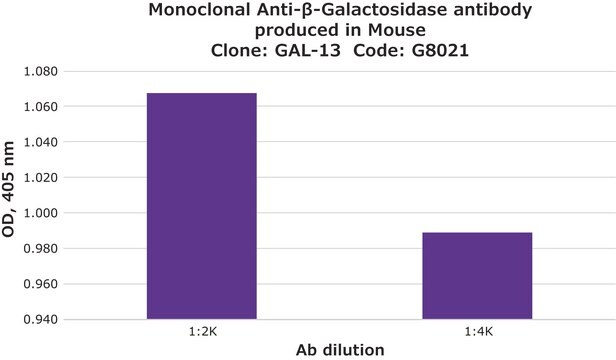SAB4200805
Anti-β-Galactosidase antibody, Mouse monoclonal
clone GAL-13, purified from hybridoma cell culture
Sinônimo(s):
Anti-Beta-gal, Anti-Beta-galactosidase, Anti-Lactase
About This Item
Produtos recomendados
fonte biológica
mouse
forma do anticorpo
purified from hybridoma cell culture
tipo de produto de anticorpo
primary antibodies
clone
GAL-13, monoclonal
descrição
Research area: Microbiome
forma
buffered aqueous solution
reatividade de espécies
E. coli
embalagem
antibody small pack of 25 μL
concentração
~1.0 mg/mL
técnica(s)
immunofluorescence: suitable
immunohistochemistry: suitable
indirect ELISA: 0.5-1 μg/mL using anti-Mouse antibody for coating, primary Anti-Beta-GAL antibody followed by addition of β-d-galactosidase enzyme from E. coli and 2-Nitrophenyl β-D-galactopyranoside as substrate.
Isotipo
IgG1
Condições de expedição
dry ice
temperatura de armazenamento
−20°C
modificação pós-traducional do alvo
unmodified
Informações sobre genes
Escherichia coli K12 ... Lacz(945006)
Categorias relacionadas
Descrição geral
Imunogênio
Aplicação
Ações bioquímicas/fisiológicas
forma física
Outras notas
Not finding the right product?
Try our Ferramenta de seleção de produtos.
Código de classe de armazenamento
10 - Combustible liquids
Classe de risco de água (WGK)
WGK 1
Ponto de fulgor (°F)
Not applicable
Ponto de fulgor (°C)
Not applicable
Certificados de análise (COA)
Busque Certificados de análise (COA) digitando o Número do Lote do produto. Os números de lote e remessa podem ser encontrados no rótulo de um produto após a palavra “Lot” ou “Batch”.
Já possui este produto?
Encontre a documentação dos produtos que você adquiriu recentemente na biblioteca de documentos.
Nossa equipe de cientistas tem experiência em todas as áreas de pesquisa, incluindo Life Sciences, ciência de materiais, síntese química, cromatografia, química analítica e muitas outras.
Entre em contato com a assistência técnica








